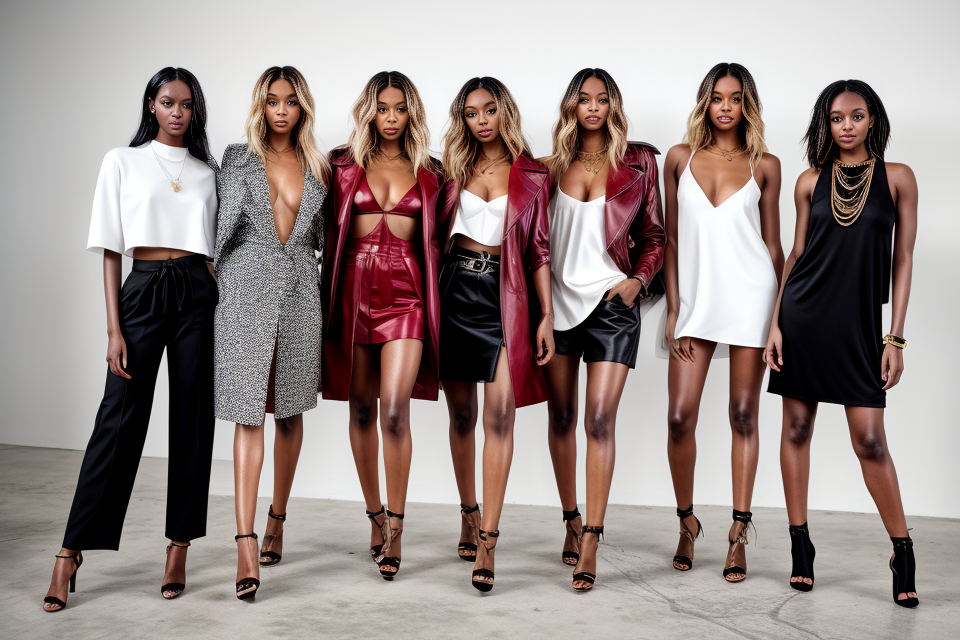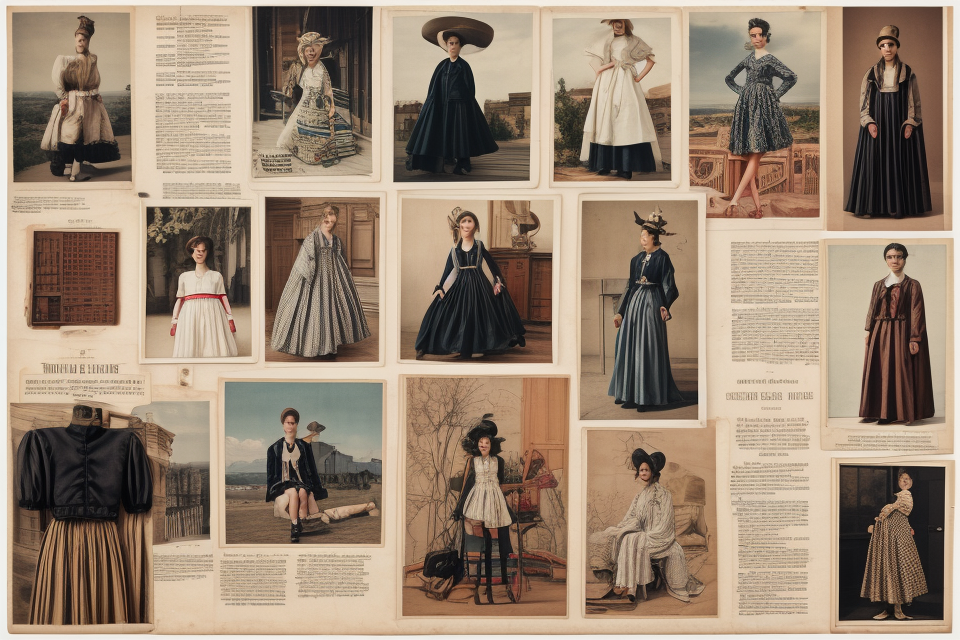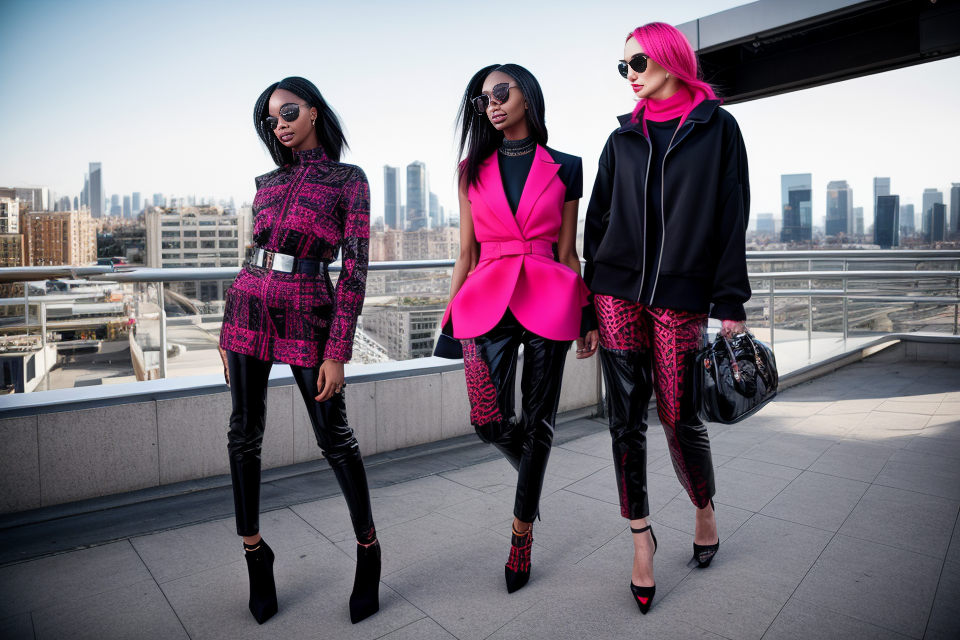
Fashion is an ever-evolving industry that has always been at the forefront of trends. With the advent of social media and the rise of influencers, it has become increasingly difficult to predict what the next big thing in fashion will be. However, the question remains – can fashion trends be predicted? In this article, we will explore the various factors that contribute to the prediction of fashion trends and examine whether it is possible to accurately predict the next big thing in fashion. From analyzing past trends to studying consumer behavior, we will delve into the intricacies of the fashion industry and try to uncover the truth behind this fascinating topic.
To some extent, fashion trends can be predicted through analysis of past trends, current events, and cultural shifts. However, the unpredictable nature of fashion means that it is often difficult to accurately predict future trends. Fashion is influenced by a wide range of factors, including celebrity endorsements, social media, and changing consumer preferences, which can make it challenging to predict which trends will gain popularity in the future. Additionally, the fast-paced and constantly evolving nature of the fashion industry means that trends can change quickly and unexpectedly. Therefore, while it is possible to make educated guesses about future fashion trends, it is important to remain flexible and open to new ideas and influences.
Understanding Fashion Trends
Factors Influencing Fashion Trends
Fashion trends are ever-changing and unpredictable, but there are certain factors that can influence their emergence and popularity. Here are some of the key factors that impact fashion trends:
Cultural Shifts
Cultural shifts play a significant role in determining the direction of fashion trends. Changes in societal values, beliefs, and lifestyles can lead to new fashion trends that reflect these changes. For example, the rise of environmentalism has led to an increased interest in sustainable fashion, which has influenced the design and production of clothing.
Celebrity Influence
Celebrities are often considered trendsetters in the fashion industry. They have the power to influence the public’s taste and preferences through their personal style and fashion choices. Celebrities with a large following can create a buzz around a particular fashion trend, making it popular among their fans and followers.
Technological Advancements
Technology has also had a significant impact on fashion trends. Advances in technology have made it possible to produce clothing faster and more efficiently, which has led to a greater variety of styles and designs. In addition, social media platforms such as Instagram and TikTok have given rise to new fashion trends that spread quickly through online communities.
Overall, these factors and others can contribute to the emergence and popularity of fashion trends. While it may be difficult to predict exactly which trends will emerge in the future, understanding the factors that influence them can help us anticipate and adapt to changes in the fashion industry.
Analyzing Past Trends
Retrospective Analysis
Retrospective analysis involves examining past trends to identify patterns and determine which elements were successful and which were not. This can be done by analyzing fashion magazines, runway shows, and social media platforms to identify key styles, colors, and silhouettes that were popular in previous years.
Cyclical Patterns
Cyclical patterns refer to the recurrence of fashion trends over time. This can be observed in the fashion industry, where certain styles and silhouettes that were popular in the past become popular again after a period of time. For example, the bell-bottom jeans that were popular in the 1970s have made a comeback in recent years.
Seasonal Trends
Seasonal trends refer to the fashion trends that are popular during a particular season. For example, during the summer months, lighter fabrics and brighter colors are popular, while during the winter months, warmer fabrics and darker colors are popular. These seasonal trends are often driven by changes in weather and can be influenced by cultural events and celebrations.
By analyzing past trends, fashion forecasters can identify patterns and make predictions about future trends. This can help fashion brands and retailers to anticipate consumer demand and stay ahead of the curve in terms of fashion trends.
Predicting Future Fashion Trends
Methods of Prediction
Market Research
Market research is a common method used to predict future fashion trends. This involves gathering data on consumer preferences, buying habits, and opinions through surveys, focus groups, and other research techniques. By analyzing this data, fashion brands and designers can identify emerging trends and adjust their products and marketing strategies accordingly.
Social Media Analytics
Social media analytics is another tool used to predict future fashion trends. By monitoring social media platforms such as Instagram, Twitter, and Facebook, fashion brands and designers can track the popularity of certain styles, colors, and patterns, as well as identify influencers and trendsetters. This data can be used to inform the development of new products and to identify emerging trends that may not yet be widely recognized.
Fashion Forecasting Agencies
Fashion forecasting agencies are specialized organizations that provide insights and analysis on future fashion trends. These agencies conduct research on consumer behavior, cultural trends, and emerging technologies to identify key themes and patterns that will shape the fashion industry in the coming years. By subscribing to these services, fashion brands and designers can stay ahead of the curve and develop products that are aligned with future trends.
Overall, predicting future fashion trends requires a combination of market research, social media analytics, and fashion forecasting. By using these methods, fashion brands and designers can stay competitive and ensure that their products are relevant and appealing to consumers.
Challenges in Prediction
Predicting future fashion trends is a complex task, fraught with challenges that can make it difficult to accurately forecast what will be popular in the future. One of the main challenges is the unpredictable nature of cultural shifts. Fashion trends are heavily influenced by cultural factors such as social, economic, and political events, and these can change rapidly and unpredictably. For example, the COVID-19 pandemic has had a significant impact on the fashion industry, with many designers and retailers having to adapt to a new normal.
Another challenge is the rapid pace of technological change. Advances in technology are constantly changing the way people live and work, and this can have a significant impact on fashion trends. For example, the rise of social media has led to a greater focus on self-expression and individuality in fashion, while the growth of e-commerce has led to a shift towards more practical and functional clothing.
Consumer behavior is also a key factor that can vary greatly and make it difficult to predict future fashion trends. Consumers are influenced by a wide range of factors, including social media, celebrity culture, and even the weather, and their preferences can change rapidly. For example, the rise of sustainable fashion has led to a greater focus on ethical and environmentally friendly clothing, while the rise of athleisure has led to a shift towards more comfortable and functional clothing.
In summary, predicting future fashion trends is a complex task that is influenced by a wide range of factors, including cultural shifts, technological change, and consumer behavior. While it is possible to make predictions based on current trends and forecasts, it is important to recognize that these predictions are not always accurate and that the fashion industry is constantly evolving.
Successful Predictions
Predicting future fashion trends is a complex task that requires a deep understanding of consumer behavior, market trends, and cultural influences. Despite the challenges, there have been instances where fashion forecasters have successfully predicted upcoming trends. In this section, we will explore some examples of accurate predictions and the factors that contributed to their success.
Examples of Accurate Predictions
One notable example of an accurate prediction was made by the fashion forecasting firm, WGSN, in 2012. They predicted that the “athleisure” trend, which involves wearing athletic clothing as everyday wear, would become a dominant fashion trend. This prediction proved to be highly accurate, as the athleisure trend became a global phenomenon, with sales of activewear reaching $48 billion in 2017.
Another example of a successful prediction was made by the fashion magazine, Vogue, in 2016. They predicted that the “normcore” trend, which involves embracing a minimalist and understated style, would become popular. This prediction also proved to be accurate, as the normcore trend gained momentum in the following years, with many designers incorporating minimalist and neutral-toned designs into their collections.
Factors Contributing to Success
The success of these predictions can be attributed to several factors. One of the key factors is a deep understanding of consumer behavior and the ability to identify emerging trends. This requires a combination of data analysis, market research, and trend analysis.
Another factor is the ability to identify and interpret cultural influences, such as social and political changes, that can impact fashion trends. For example, the rise of sustainable fashion can be attributed to growing concerns about environmental issues and the impact of fast fashion on the environment.
Finally, successful predictions often require a willingness to take risks and challenge conventional wisdom. This involves looking beyond traditional fashion centers and considering emerging markets and cultures, as well as new technologies and materials, which can disrupt established fashion trends.
Overall, successful predictions of future fashion trends require a combination of data analysis, cultural awareness, and creativity. By understanding the factors that contribute to successful predictions, fashion forecasters can develop more accurate and relevant predictions that can help shape the future of fashion.
The Role of AI in Predicting Fashion Trends
Artificial Intelligence (AI) has become an integral part of our lives, and it is no surprise that it has made its way into the fashion industry as well. With the vast amount of data available on social media platforms, fashion blogs, and e-commerce websites, AI can be used to predict future fashion trends with remarkable accuracy.
Machine Learning Algorithms
Machine learning algorithms are a subset of AI that allows computers to learn from data without being explicitly programmed. In the fashion industry, machine learning algorithms can be used to analyze data from social media platforms such as Instagram and Twitter to identify patterns and trends. For example, a machine learning algorithm can be trained to recognize certain keywords, hashtags, and images related to fashion trends and use this information to predict future trends.
Natural Language Processing
Natural language processing (NLP) is another branch of AI that allows computers to understand human language. In the fashion industry, NLP can be used to analyze fashion blogs, articles, and reviews to identify key words and phrases related to fashion trends. By analyzing the sentiment of these texts, NLP can help predict the popularity of certain trends and identify new trends that are emerging.
Image Recognition
Image recognition is a third application of AI in the fashion industry. With the help of image recognition technology, AI can analyze images of clothing and accessories to identify trends in color, pattern, and style. This technology can be used to analyze runway shows, fashion magazines, and street style photos to identify emerging trends and predict future fashion trends.
In conclusion, AI has the potential to revolutionize the way we predict future fashion trends. By analyzing vast amounts of data from social media, fashion blogs, and e-commerce websites, machine learning algorithms, natural language processing, and image recognition technology can help identify patterns and trends, predict future trends, and even suggest new trends that may not have been identified otherwise.
The Limitations of AI in Predicting Fashion Trends
Artificial intelligence (AI) has revolutionized many industries, including fashion. However, despite its many advantages, AI is not without its limitations when it comes to predicting fashion trends. Here are some of the reasons why:
- Inability to Capture Human Emotion: Fashion is not just about what looks good or what is trendy; it is also about how people feel when they wear certain clothes. AI may be able to analyze data on what is popular, but it cannot capture the emotional response that people have to certain styles or colors. For example, a person may love a particular dress because it reminds them of a happy memory, and AI may not be able to capture that sentiment.
- Cultural Biases: Fashion is a reflection of culture, and what is considered fashionable in one culture may not be in another. AI algorithms are only as good as the data they are trained on, and if that data is biased towards a particular culture or demographic, the predictions will be too. For example, if an AI algorithm is trained on data from a predominantly Western society, it may not be able to accurately predict fashion trends in other cultures.
- Limited Datasets: AI algorithms require large amounts of data to make accurate predictions. However, the data available on fashion trends may be limited, particularly when it comes to niche or emerging trends. This means that AI may not be able to predict the next big thing in fashion, particularly if it is something completely new and unexpected.
Overall, while AI can be a useful tool in predicting fashion trends, it is not without its limitations. It is important to remember that fashion is a complex and multifaceted industry, and there is no substitute for human intuition and creativity when it comes to predicting what will be popular in the future.
The Future of Fashion Trend Prediction
Ongoing Developments
Advances in AI and Machine Learning
- In recent years, artificial intelligence (AI) and machine learning (ML) have emerged as significant tools for predicting fashion trends.
- AI algorithms can analyze vast amounts of data, including social media posts, fashion blogs, and even consumer search queries, to identify patterns and predict upcoming trends.
- ML algorithms can learn from past trends and fashion cycles to generate predictions about future trends, taking into account factors such as seasonality, cultural events, and celebrity influences.
Integration of IoT Devices
- The Internet of Things (IoT) has the potential to revolutionize the way fashion trends are predicted and forecasted.
- IoT devices, such as smart clothing and wearable technology, can collect real-time data on consumer preferences, fashion choices, and usage patterns.
- This data can be analyzed to generate insights into emerging trends and to identify areas where innovation is needed.
Greater Focus on Sustainability
- Sustainability is becoming an increasingly important factor in fashion trend prediction.
- Consumers are becoming more conscious of the environmental impact of their fashion choices, and are seeking out sustainable and ethical fashion options.
- Fashion brands and designers are responding to this demand by incorporating sustainable materials and practices into their collections, and by focusing on circular fashion models that reduce waste and promote recycling.
- This shift towards sustainability is likely to have a significant impact on fashion trend prediction in the coming years, as brands and designers seek to meet the evolving needs and values of their customers.
Potential Impact on the Fashion Industry
Streamlined Production Processes
Fashion trend prediction has the potential to revolutionize the production processes in the fashion industry. With accurate forecasting, fashion brands can optimize their supply chains and production schedules, reducing lead times and minimizing inventory holding costs. This streamlined approach can lead to cost savings and improved efficiency for fashion brands, allowing them to allocate resources to other areas of the business.
Tailored Marketing Strategies
By understanding consumer preferences and predicting future trends, fashion brands can develop tailored marketing strategies that resonate with their target audience. This can result in increased customer engagement and higher sales, as marketing efforts are focused on products that are more likely to be in demand. Furthermore, fashion trend prediction can help brands identify emerging trends and capitalize on them before they become mainstream, giving them a competitive edge in the market.
Reduced Waste and Environmental Impact
Accurate fashion trend prediction can also contribute to reducing waste and minimizing the environmental impact of the fashion industry. By forecasting demand for specific products, fashion brands can avoid overproduction and reduce the amount of unsold inventory that ends up in landfills. This can lead to a more sustainable fashion industry, with reduced environmental costs and a lower carbon footprint.
In conclusion, the potential impact of fashion trend prediction on the fashion industry is significant. By improving production processes, developing tailored marketing strategies, and reducing waste, fashion trend prediction has the potential to transform the industry and create a more sustainable and efficient fashion ecosystem.
Ethical Considerations
Privacy Concerns
As fashion trend prediction becomes more sophisticated, there are growing concerns about the use of personal data. With the increasing amount of data being collected by technology companies and fashion brands, there is a risk that sensitive information may be accessed or misused. It is essential to ensure that individuals’ privacy is protected and that their data is not exploited without their consent.
Potential Misuse of Technology
Another ethical consideration is the potential misuse of technology in fashion trend prediction. There is a risk that algorithms and artificial intelligence could be used to manipulate trends or influence consumer behavior. This could result in a homogenization of fashion, with a few dominant trends dictating what everyone should wear. It is important to ensure that technology is used responsibly and that it does not undermine the creativity and diversity of the fashion industry.
Impact on Small Designers and Brands
Fashion trend prediction technology may also have an impact on small designers and brands. With larger companies able to use advanced algorithms to predict trends and respond quickly to changing consumer preferences, there is a risk that smaller brands may struggle to compete. It is important to ensure that the benefits of fashion trend prediction technology are shared fairly across the industry, and that small designers and brands are not disadvantaged.
FAQs
1. What is meant by fashion trends?
Fashion trends refer to the popular styles, colors, patterns, and designs that are in vogue at a particular time. These trends can be seen in clothing, accessories, and even footwear. Fashion trends are constantly changing, and new trends emerge every season.
2. Can fashion trends be predicted?
Yes, fashion trends can be predicted to some extent. Many fashion experts and analysts study past trends, current market trends, and cultural influences to predict what will be popular in the future. They also attend fashion shows, review fashion magazines, and monitor social media to stay up-to-date on the latest trends.
3. How are fashion trends predicted?
Fashion trends are predicted through a combination of techniques, including market research, data analysis, and expert opinions. Some analysts use machine learning algorithms to analyze data from social media, fashion blogs, and other sources to identify patterns and predict future trends. Others rely on their expertise and experience in the fashion industry to make predictions.
4. Are fashion trends always accurate?
No, fashion trends are not always accurate. Predicting fashion trends is not an exact science, and there are many factors that can influence what becomes popular. For example, unexpected events or cultural shifts can change the direction of fashion trends. Additionally, personal preferences and individual style can impact what someone chooses to wear.
5. Why is it important to predict fashion trends?
Predicting fashion trends is important for fashion designers, retailers, and manufacturers who need to stay ahead of the curve and anticipate consumer demand. By predicting trends, they can create and produce products that are in line with what consumers want, which can lead to increased sales and profitability. Additionally, predicting trends can help fashion industry professionals plan their marketing and advertising strategies.


